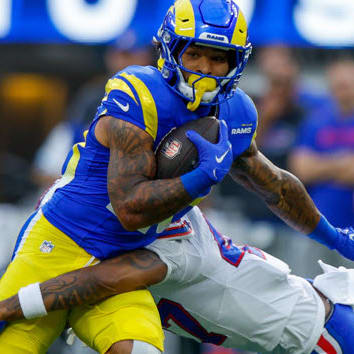The following post-combine top-70 dynasty rankings for the 2024 NFL Draft class is broken into nine tiers. These rankings are for one-QB leagues with three starting WRs and PPR scoring.
TIER 1 (3)
Marvin Harrison, WR, Ohio State (6-3, 209)
Rome Odunze, WR, Washington (6-3, 213)
Malik Nabers, WR, LSU (6-0, 200)
Marvin Harrison and Rome Odunze are extremely high-floor, high-ceiling receiver prospects. They will likely command team-leading target shares early on in their career wherever they go, and they'll likely do so with above-average efficiency, if not something closer to league-leading.
Malik Nabers is not as obviously polished as Harrison or Odunze, and he's a different category of receiver (smaller) than those two. Despite being significantly smaller and potentially much more raw, Nabers still has a case to hang with Harrison and Odunze because he might be able to make up the difference with uncommon big-play ability. While Nabers' route running is not on the level of Harrison or Odunze, Nabers appears to be an effortless tracker with exceptional ball skills, which could make him a memorable downfield threat. Nabers is also the most dangerous of the three after the catch, showing a menacing lean when he hits the gas. Nabers was outrageously productive at LSU yet won't turn 21 until late July, indicating rare upside. He just doesn't project for the reception upside that Harrison and Odunze do and might need to make up the difference with YPT, touchdown percentage, etc.
TIER 2 (1)
Brock Bowers, TE, Georgia (6-3, 243)
Brock Bowers is a high-volume, high-efficiency target at tight end. He doesn't possess the freak factor of Kyle Pitts but Bowers could actually have a higher floor because he's better at carving out the mundane, stat-padding kind of targets that quickly drive up the PPR point count. Bowers should be able to pile up big numbers even with dubious quarterback play, not unlike how Trey McBride did with the Cardinals in 2023. Bowers offers an NFL offense a lot of accessible ways to move the ball, so he'll likely tempt any offensive coordinator into feeding easy targets.
TIER 3 (2)
Ladd McConkey, WR, Georgia (6-0, 186)
Caleb Williams, QB, USC (6-1, 214)
Ladd McConkey offers a plug-and-play slot and flanker skill set that should make him a target in the first 40 picks. It's easy to see him drawing targets immediately in the NFL, because pairing 4.39 speed with his polished skill set could make him one of the best WR2 prospects in the league currently.
Caleb Williams is a Tier 1 player in Superflex leagues, and for 1QB he of course has major upside as well. As much as he's not a flawless prospect, he does appear to be the best in this class and a worthwhile No. 1 pick.
TIER 4 (9)
Keon Coleman, WR, Florida State (6-3, 213)
Xavier Worthy, WR, Texas (5-11, 165)
Adonai Mitchell, WR, Texas (6-2, 205)
Ricky Pearsall, WR, Florida (6-1, 189)
Brian Thomas, WR, LSU (6-3, 209)
Malachi Corley, WR, Western Kentucky (5-11, 215)
Drake Maye, QB, North Carolina (6-4, 223)
Jayden Daniels, QB, LSU (6-4, 210)
Ja'Tavion Sanders, TE, Texas (6-4, 245)
Keon Coleman couldn't provide baseline-level returns for Florida State on a 26.8 percent target share in 2023, and with that there's reasonable concern that Coleman can't support a WR1 target rate in the NFL and remain above baseline. With that said, there remains ample reason to think Coleman can still turn out an above-average starting NFL receiver, even if he technically lands more around WR2 territory. Coleman's 2022 season with Michigan State was much more impressive and arguably more meaningful than his one-off season at Florida State. You saw Jayden Reed torch the NFL as a rookie, right? Coleman matched Reed's 2022 production with the Spartans, and Coleman was only 19 years old at the time. His 4.61-second 40-yard dash isn't much of a concern given that Coleman's game was never much about stretching the field, and he notably logged the highest speed during the gauntlet drill at the combine, which indicates a discrepancy between his 40 time and his play speed, especially during the route running process.
Xavier Worthy broke John Ross' combine 40 record by logging a remarkable 4.21-second 40. His hands are below average but Worthy drew targets at a blistering pace as the WR1 at Texas, even with the talented Mitchell playing in the same offense.
Adonai Mitchell was faster than expected with a 4.34-second 40, though he also checked in a bit shorter than expected after previously being listed at 6-foot-4. No matter, the speed at the very least offsets anything lost with the height adjustment, and the height difference might not be meaningful. Mitchell should be a high-YPT, high-touchdown percentage target in the NFL, just as he was at Texas, but the one potential limitation is his per-snap target rate. If Mitchell can draw targets more rapidly than he did at Texas, though, he could have WR1 potential for both real football and fantasy purposes.
Ricky Pearsall is much older than the other wideouts in this range (turns 24 on Sept. 9) and that raises a valid concern over the value of his otherwise excellent production at Florida, which occurred at ages 22 and 23 years old – ages at which nearly all viable prospects are already in the NFL. The reason to think Pearsall might be exempt from age cutoffs is that he posted elite athletic testing at the combine (4.41-second 40, 42-inch vertical, 129-inch broad jump, 6.64-second three-cone drill) and had previously posted adequate production at Arizona State at age 21 (above baseline on 22 percent target share). Pearsall's target share was modest at both Arizona State and Florida, however, indicating WR2 ceiling despite the possibility of plus efficiency at that target rate.
Similarly to Mitchell, Brian Thomas had incredible athletic testing at the combine (4.33-second 40) and was memorably explosive for LSU as a big-play specialist, but it's not clear if Thomas' modest target rate was due to limitations in his game or just out of respect to the rare talents of Malik Nabers. Thomas at the very least has a compelling mix of downfield and red-zone traits, even if the volume is never top notch.
Malachi Corley did not test at the combine but is expected to test well at Western Kentucky's pro day. At 215 pounds with memorable YAC ability, no one can escape the Deebo Samuel comp with Corley. It's impossible.
Drake Maye has legitimate dual-threat ability (10+ carries per game as a starter at North Carolina) and otherwise has the tools and production to project as a competent pocket passer at the NFL level, but his production isn't as clean as in Williams' case.
Jayden Daniels could fit well in the NFL if used like Jalen Hurts in 2022-2023, which is to say contained pass attempt volume in a run-heavy offense. Daniels' accuracy on touch passes is exceptional and this makes him dangerous when throwing downfield from a clean pocket, but a severe lack of velocity and questionable passing metrics indicate limitations in pass attempt volume. If Daniels is given proper cover as a passer, though, he could boast explosive YPA and touchdown percentages as a passer while otherwise ranking among the league rushing leaders at quarterback. Both Daniels and Maye are boom-or-bust upside picks, just slightly different types. They're both worth moving up at least one tier in superflex.
Ja'Tavion Sanders was somewhat disappointing at the combine (4.69-second 40 at 245 pounds), but his athletic profile is still adequate and the more important part of his overall prospect profile all along was the fact that he produced so notably even while competing with Xavier Worthy and Adonai Mitchell for targets. Sanders won't turn 21 until March 27 and his developmental peak is likely years away, but he eventually projects as an above-average starting tight end in both real life and fantasy football.
TIER 5 (11)
Troy Franklin, WR, Oregon (6-2, 176)
Jacob Cowing, WR, Arizona (5-8, 168)
Jermaine Burton, WR, Alabama (6-0, 196)
Devontez Walker, WR, North Carolina (6-2, 193)
Trey Benson, RB, Florida State (6-0, 216)
Jaylen Wright, RB, Tennessee (5-11, 210)
Isaac Guerendo, RB, Lousiville (6-0, 220)
Blake Corum, RB, Michigan (5-8, 205)
Kimani Vidal, RB, Troy (5-8, 213)
Bo Nix, QB, Oregon (6-2, 214)
J.J. McCarthy, QB, Michigan (6-3, 219)
Troy Franklin still has a good prospect profile but quietly disappointed a bit at the combine, running 'only' a 4.41-second 40 at a skinny 6-foot-2, 176 pounds. Franklin's production at Oregon was at least one magnitude better than what Tyquan Thornton posted at Baylor, but their traits otherwise are alarmingly similar.
Jacob Cowing still has a perilous path as a fantasy prospect due to his tiny build, but if Tank Dell can prove an exception then Cowing may qualify for the same exempt status to the height/weight cutoffs normally demanded of receivers. Cowing was similarly productive at UTEP and Arizona as Dell was at Houston, and Cowing's 4.38-second 40 is a major improvement on Dell's 4.49-second 40.
Jermaine Burton sort of blended into the background in this deep and strong receiver class, but there are a lot of indicators saying he will be an above-average starting NFL receiver at some point. His target share might lag a bit relative to his big-play ability, but Burton's 4.45 speed and polished downfield game give him a real chance to thrive as a high-efficiency WR2 type.
Devontez Walker is kind of like a discount version of Brian Thomas, showing encouraging big-play production at Kent State and North Carolina while verifying his long-range speed by logging a 4.36-second 40. His target shares might be limited at the NFL level, but there's reason to think Walker can thrive vertically as a WR2 type.
Trey Benson has intriguing big-play speed (4.39-second 40) and produced explosively as both a runner and receiver at Florida State, but his somewhat upright lean and injury history make it unclear whether he'll ever be a workhorse back in the NFL. There's still value in a big-play back on moderate usage, especially since Benson looks capable as a pass catcher, but he might not have regular 20-carry ability even despite his bigger build.
Jaylen Wright is a burner by running back standards (4.38-second 40) and showed unique long-range ability at Tennessee. Volume doesn't seem to be in his future as a runner, though, both because his frame doesn't obviously support it and because his stride might be a little wild to support volume as a between-the-tackles runner.
Isaac Guerendo is basically the same category as Benson and Wright – a big-play burner capable of producing as either a runner or receiver, but one whose build and stride don't look like an obviously great fit between the tackles. Guerendo's 4.33 40 was fastest among running backs.
Blake Corum (4.53-second 40) doesn't offer the big-play ability of Benson, Wright or Guerendo, but he has a more varied skill set than any of them and thus might have better volume upside in the NFL despite being the smallest and slowest of the three. Corum was a max-volume, high-efficiency runner at Michigan and should appeal broadly to NFL teams since he can contribute on all run designs and all passing situations. Although Corum was a workhorse at Michigan, he could just as easily play out of the bullpen, including for passing-down functions.
Kimani Vidal was one of the unlikely winners of the combine, weighing in at a dense 213 pounds to offset his otherwise short 5-foot-8 frame before opening eyes with a 4.46-second 40. With athletic testing like that there are basically no remaining question about Vidal as an NFL back other than the question of how high he gets drafted by the fallible league front offices.
Bo Nix doesn't get much hype these days but he remains a candidate to go in the first round of the NFL draft and he has a history of producing both as a passer and runner. I personally have trouble imagining him turning out any worse than an Andy Dalton type.
J.J. McCarthy is the less developed but more tantalizing alternative to more veteran prospects like Daniels and Nix. Daniels and Nix seemingly have certain set limitations, whereas with McCarthy the hope is that as the much younger prospect he might have greater developmental upside. McCarthy hasn't run as often as Maye or Nix but might have similar ability in that regard.
TIER 6 (8)
Roman Wilson, WR, Michigan (5-11, 185)
Xavier Legette, WR, South Carolina (6-1, 221)
Jonathon Brooks, RB, Texas (6-0, 216)
MarShawn Lloyd, RB, USC (5-9, 220)
Ray Davis, RB, Kentucky (5-8, 211)
Michael Penix, QB, Washington (6-2, 216)
Cade Stover, TE, Ohio State (6-4, 247)
Ben Sinnott, TE, Kansas State (6-4, 250)
Roman Wilson might warrant a spot higher than this – he'll definitely get drafted ahead of the receivers outside of Tier 5 – but the concern is that Wilson might get stuck as a decoy field-stretcher in the NFL more than a featured target. Wilson couldn't convincingly take targets away from Ronnie Bell or Cornelius Johnson, and there might be a reason for that.
Xavier Legette probably won't draw a high target share in the NFL but could make up for limited volume with plus efficiency and touchdown potential if he lands in the right offense. Leggette's game lacks dimensions but he has clear strength as a vertical threat with plus speed and ball skills.
Jonathon Brooks would project as a potential Day 2 type but his November ACL tear makes it difficult to pinpoint his prospect grade or his 2024 availability. NFL.com's comparison of Jamaal Charles is way over the top, but Brooks looks at least competent as a runner and probably above average as a pass catcher.
MarShawn Lloyd has a clearly valuable combination of anchor, burst, change of direction and speed. Overall he's an explosive and violent runner with an ideal lean to engage contact, and there's reason to believe he can move the ball at the NFL level. The problem with his projection is that he has an extensive injury history and an even more notable history of fumbling. Lloyd's fumbling occurred at an unacceptable rate at both USC and South Carolina and he quite simply will not see the NFL field if he doesn't get it under control.
Ray Davis overcame dysfunctional offenses at Temple, Vanderbilt and Kentucky to produce well at each one, and he brings pass-catching ability along with a 4.51-second 40 on a dense (if short) frame. Davis might not hold up to a three-down workload at the NFL level but at the very least he has a three-down skill set.
Michael Penix was productive at both Indiana and Washington and boasts a notably strong arm with an extended history of avoiding sacks. I'm personally skeptical that his rhythm will fit well in most NFL offenses, and his completion percentages leave something to be desired. His injury history might work against his draft stock a bit, too.
Cade Stover is the first Ohio State tight end in forever who actually catches passes, and he seems good at it. Though unremarkable, his 4.65-second 40 is more than enough to keep him in Day 2 of the NFL draft and project for a potential starting role within two years.
Ben Sinnott might have a lower floor than Stover but potentially a higher ceiling thanks to what could prove to be memorable YAC ability at tight end. Sinnott absorbs contact more like Mike Alstott than any tight end of distant memory, then again Sinnott has a somewhat odd lean that might be held against him – Sinnott runs like he's wearing a neck pad from the 90s – but his slight hunch hasn't held back Sinnott at all as a receiver to this point. Sinnott claimed 19.2 percent of Kansas State's targets in 2023 and easily exceeded the team baseline by catching 64.5 percent of his targets at 8.9 YPT.
TIER 7 (18)
Jalen McMillan, WR, Washington (6-1, 197)
Ja'Lynn Polk, WR, Washington (6-1, 203)
Jamari Thrash, WR, Louisville (6-0, 188)
Malik Washington, WR, Virginia (5-9, 191)
Cornelius Johnson, WR, Michigan (6-3, 212)
Luke McCaffrey, WR, Rice (6-2, 198)
Brenden Rice, WR, USC (6-2, 208)
Javon Baker, WR, UCF (6-1, 202)
Dylan Laube, RB, New Hampshire (5-10, 206)
Isaiah Davis, RB, South Dakota State (6-0, 218)
Braelon Allen, RB, Wisconsin (6-1, 235)
Audric Estime, RB, Notre Dame (5-11, 221)
Bucky Irving, RB, Oregon (5-9, 192)
Joe Milton, QB, Tennessee (6-5, 235)
Jaheim Bell, TE, Florida State (6-2, 241)
Tip Reiman, TE, Illinois (6-5, 271)
Theo Johnson, TE, Penn State (6-6, 259)
Erick All, TE, Iowa (6-4, 253)
Jalen McMillan and Ja'Lynn Polk were similarly lethal as the WR2 for Washington behind WR1 Rome Odunze, with McMillan dominating in 2022 and Polk gaining in 2023 in light of an injury to McMillan. Neither player projects as more than a WR2 ceiling and more likely fall into the WR3/4 kind of territory for most offenses, but both players checked the box at the combine and otherwise have strong production bolstering their overall profile.
Jamari Thrash is skinny and less than imposing as an athlete, but his production was good at both Georgia State and Louisville, and his 4.46-second 40 indicates the ability to threaten at all levels as a route runner. Thrash seems dependent on separation due to poor traits for in-traffic play, but there's a chance he separates well enough to thread the needle at the pro level.
Malik Washington is built like a running back – a short one with limited lateral ability. The overall wide receiver acumen is strong and Washington otherwise boasts uniquely powerful explosiveness in short areas, but if his lateral and vertical abilities both are limited then he might not be able to help NFL offenses as much as he did the Virginia or Northwestern ones.
Although Cornelius Johnson gets much less attention there's reason to think he might be surprisingly close to teammate Roman Wilson as a prospect. Wilson will go earlier – potentially much earlier – but Johnson probably has a high enough floor to stick around and otherwise has plus athleticism at his disposal (4.44-second 40).
While there's nothing wrong with the athletic testing of Luke McCaffrey (4.46-second 40, 6.7-second three-cone drill), it's also not obviously different than that of his brother Max, who quietly burned out quickly as an undrafted player in 2016. The difference between the two is Luke is a former top quarterback recruit (Nebraska), and his receiver production the last two years still graded as better than what Max mustered at Duke. The McCaffrey Brother brand has also improved in general since 2017, for a reason you can probably guess.
Brenden Rice and Javon Baker are a similar category of fringe prospect – big receivers with decent but merely viable athleticism and otherwise mediocre production profiles. Both players should stick around the league for a while, but it's not obvious how they'll claim enough opportunity to amount to mainstream fantasy factors.
Dylan Laube will need to switch roles in his jump to the NFL, shedding the workhorse role he had at New Hampshire for one more focused on passing-down work in the NFL. Laube showed plus pass-catching ability and could emerge as a noteworthy third-down type after demonstrating viable athleticism at the combine (4.54-second 40, 37-inch vertical).
Isaiah Davis was a high-volume, high-efficiency runner at South Dakota State and shows a fairly convincing bully mentality as a power runner. His athletic testing (4.57-second 40) was somewhat ambiguous, however.
Braelon Allen didn't do enough testing at the combine to give a reliable sense of his overall athletic profile, and the Wisconsin pro day track he'll eventually run on is extremely fast. If Allen runs a 4.50-second 40 it wouldn't necessarily translate to any better than a 4.7 on the combine track. Still, Allen's Wisconsin production gives reason to think he has real skills to work with if the tools prove sufficient.
Perhaps it's worth monitoring how he might follow up the effort at the Notre Dame pro day, but Audric Estime was highly disappointing with a 4.71-second 40 at the combine. To cut weight down to 221 and still fall short of the 4.6s makes it more difficult to imagine Estime's otherwise standout skill level translating to an NFL level that generally demands plus tools.
Bucky Irving was one of the most disappointing players at the combine, checking in lighter than expected and then logging flat jumps (29.5-inch vertical, 115-inch broad). His 4.55-second 40 isn't bad exactly, but it would read a lot better at 205 pounds than 192. While Irving's production at Oregon says he has plus ability as both a runner and pass catcher, his combine showing raises the concern that he might lack the athletic tools necessary for his skills to show at the NFL level.
Joe Milton almost certainly can't play as a starting NFL quarterback but weird things happen sometimes and at the very least he's worth owning in superflex leagues in case he can be flipped for better assets at the first sign of hype.
Jaheim Bell won't see the field for any inline snaps at tight end, so he'll need to do his damage as a pass-catching specialist, with the potential for some backfield snaps here and there. If Bell can earn a role as a pass-catching specialist he could become a fantasy factor, but it might be a narrow path to such an outcome given his one-dimensional skill set.
Tip Reiman has the opposite problem as Bell – at 270-plus pounds with 4.64 speed, Reiman's otherwise utility as a pass catcher might be harmed by the fact that he might also project as a plus blocker, potentially sapping him of route-running opportunities. Reiman's combination of weight and speed is highly unusual.
Theo Johnson has the same problem as Reiman – at nearly 260 pounds Johnson might appeal to offensive coordinators as much as an inline blocker as he would a route-running candidate. Then again, Johnson's 4.57-second 40 and 39.5-inch vertical are part of why Johnson is arguably the better pass-catching prospect of the two.
Erick All is kind of like the Jonathon Brooks of this tight end class – a Day 2 talent who might fall to Day 3 for season-ending injury reasons. All suffered a torn ACL on Oct. 14, which rules him out for athletic testing and leaves his Week 1 availability up to some question. If not for the injury, though, All might have made a real charge at the draft board.
TIER 8 (10)
Dillon Johnson, RB, Washington (6-0, 217)
Will Shipley, RB, Clemson (5-11, 206)
Michael Wiley, RB, Arizona (5-11, 210)
Tyrone Tracy, RB, Purdue (5-11, 209)
George Holani, RB, Boise State (5-10, 208)
Jaden Shirden, RB, Monmouth (5-8, 187)
Kendall Milton, RB, Georgia (6-2, 225)
Frank Gore Jr., RB, Southern Mississippi (5-8, 201)
Anthony Gould, WR, Oregon State (5-8, 174)
Ainias Smith, WR, Mississippi State (5-9, 190)
Dillon Johnson is slow but built for volume and anchor as a runner while boasting plus pass-catching ability. He could enjoy a stretch like Darrel Williams' peak at some point.
Will Shipley is little more than a draw back as a runner but could possess pass-catching skills sufficient for regular season snaps.
Michael Wiley might be a Kenny McIntosh type.
Tyrone Tracy was a promising receiver before he transferred to Purdue, and now he's a running back project who will turn 25 this year. Tracy might or might not have enough developmental upside for a team to continue working on his project.
George Holani is a bit light for a running back who lacks explosiveness, but if he can stay healthy he might emerge as a notable passing-down back in the NFL. He has some floor to offer but it's unclear whether it's enough to draw meaningful opportunity.
Jaden Shirden is likely the Jaleel McLaughlin of this year's class, for better or worse.
Kendall Milton is probably limited laterally and lacks big-play ability, but has an outside shot to stick around due to a convincing ability run with anchor between the tackles, even at a tall build.
Frank Gore Jr. didn't do any combine testing, and his production at Southern Mississippi is ambiguous. He would ideally test reasonably well at his pro day, because otherwise Gore doesn't obvious project better than a practice squadder.
Anthony Gould has wheels (4.39-second 40) and decent enough production working for him, but it's difficult to identify what he would have on someone like Jacob Cowing.
Ainias Smith is a similar category as Malik Washington – a stout slot guy who has ability with the ball but might struggle to draw targets in the NFL.
TIER 9 (8)
Jawhar Jordan, RB, Louisville (5-11, 193)
Tahj Washington, WR, USC (5-10, 174)
Lideatrick Griffin, WR, Mississippi State (5-10, 181)
Isaiah Williams, WR, Illinois (5-9, 182)
Jha'Quan Jackson, WR, Tulane (5-9, 188)
Johnny Wilson, WR, Florida State (6-6, 231)
Jared Wiley, TE, TCU (6-6, 249)
Tanner McLachlan, TE, Arizona (6-5, 244)
Jawhar Jordan seems to have ability from scrimmage, but his athletic tools grade close to the bottom and he won't ever be a volume candidate.
Tahj Washington, Lideatrick Griffin, Isaiah Williams and Jha'Quan Jackson all have various abilities but none projects as more than special teamers or WR5 types.
If it didn't work out for Hakeem Butler then it probably won't for Johnny Wilson, either. Maybe at tight end.
Jared Wiley and Tanner McLachlan are both skinny tight ends with some amount of speed (40s in 4.6-second range) and pass-catching ability. That might or might not be enough to earn them playing time.









































